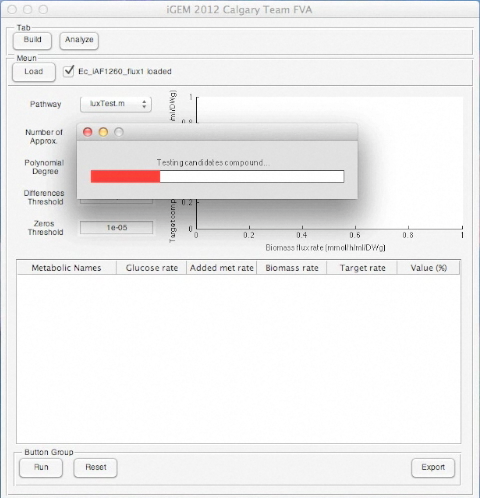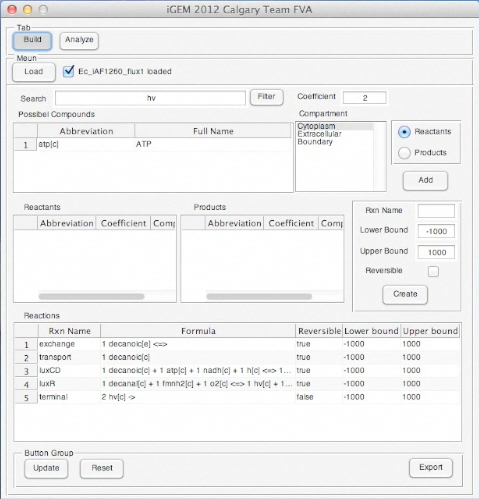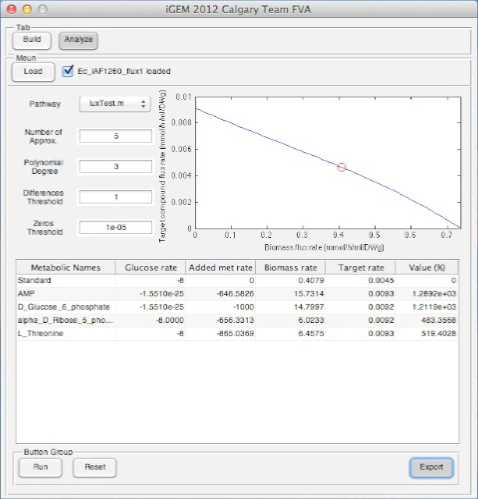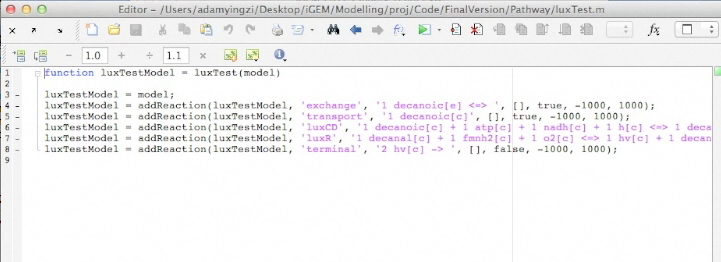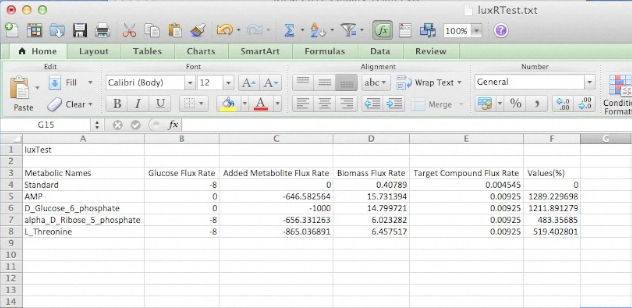Team:Calgary/Project/OSCAR/FluxAnalysis
From 2012.igem.org
Rpgguardian (Talk | contribs) |
|||
| Line 8: | Line 8: | ||
<p>In order to better implement OSCAR as a bioreactor system, it is important that we have a mechanism by which we can optimize his newly developed metabolic network. To achieve this we turned to flux variability analysis as a way of predicting ways of upregulating our target pathways (such as hydrcarbon production). We developed a MATLAB based program for predicting metabolites that can added to your media in order to increase production of compounds in synthetic <i>E. coli</i> chassis'. In addition we have made this program user friendly by designing a graphical user interface, and allowing for other teams to add their own synthetic pathways into the model. We validated this model in the wetlab to demonstrate that it can be used to optimize the Petrobrick system to save time, money, and resources.</p> | <p>In order to better implement OSCAR as a bioreactor system, it is important that we have a mechanism by which we can optimize his newly developed metabolic network. To achieve this we turned to flux variability analysis as a way of predicting ways of upregulating our target pathways (such as hydrcarbon production). We developed a MATLAB based program for predicting metabolites that can added to your media in order to increase production of compounds in synthetic <i>E. coli</i> chassis'. In addition we have made this program user friendly by designing a graphical user interface, and allowing for other teams to add their own synthetic pathways into the model. We validated this model in the wetlab to demonstrate that it can be used to optimize the Petrobrick system to save time, money, and resources.</p> | ||
| + | |||
| + | <p><center><b>Click <a href="https://static.igem.org/mediawiki/2012/2/2a/UCalgary2012_FVAFinalVersion.zip"> here </a> to download the files required to run our model!</b></center></p> | ||
<h2>Background</h2> | <h2>Background</h2> | ||
<p><b>What is Metabolic Flux Analysis?</b></p> | <p><b>What is Metabolic Flux Analysis?</b></p> | ||
| - | <p>Metabolic Flux balance analysis (FBA) is an application of linear programming to metabolic network that | + | <p>Metabolic Flux balance analysis (FBA) is an application of linear programming to metabolic network that converts each metabolite in the network into a mathematical coefficient. These coefficients can be related to each other by changes associated with each enzymatic step of the pathway. By applying a mathematical method to examine how metabolites move through the system FBA allows us to make generalized predictions about organism growth, product output, and metabolite levels inside of a cell. This analysis requires the Steady State Assumption, which states that all state variables are constant in spite of ongoing processes that strive to change them. This can be further applied to Flux Variability Analysis (FVA) which extends the process to determines the ranges of fluxes that correspond to an optimal solution determined through FBA. In other words, FVA will determine the range of values that can be achieved by modifying various inputs in the model.</p> |
| + | |||
| + | [[File:Calgary FluxExample.jpg|300px|right|Figure 1: Flux Balance Analysis. FBA involves taking a metabolic network and simulating the connections in the network as a linear algebra matrix. Each metabolite is listed vertically in the table and each reaction is listed horizontally. Based on the metabolites involved in each reaction, this changes the state of the system through change each metabolite variable.]] | ||
<p><b>What are the constraints in model?</b></p> | <p><b>What are the constraints in model?</b></p> | ||
| - | <p>Networks can be encoded as stoichiometric matrices | + | <p>Networks can be encoded as stoichiometric matrices, in which each row represents a unique metabolite and each column represents a biochemical reaction. The entries in each column of this matrix are the stoichiometric coefficients of the metabolites in the reaction. Metabolites are consumed have a negative coefficient and metabolites that are produced have a positive coefficient.</p> |
<p><b>Why use Flux Variability Analysis?</b></p> | <p><b>Why use Flux Variability Analysis?</b></p> | ||
| - | <p>Biological systems often contain redundancies that contribute to their robustness. However, flux balance analysis only returns a single flux distribution that corresponds to maximal growth under given growth conditions regardless alternate optimal solutions may exist. FVA is capable | + | <p>Biological systems often contain redundancies that contribute to their robustness. However, flux balance analysis only returns a single flux distribution that corresponds to maximal growth under given growth conditions regardless alternate optimal solutions may exist. FVA is capable of examining these redundancies by calculating the full range of numerical values for each reaction flux in a network. Consequently, FVA can be employed to study the entire range of achievable cellular functions as well as the redundancy in optimal phenotypes. FVA can also examine different ranges of bacterial growth vs. product output which is valuable in assessing validity of models in the wetlab.</p> |
<br> | <br> | ||
| - | |||
<h2>Introduction</h2> | <h2>Introduction</h2> | ||
| - | <p><b>What | + | <p><b>What Are We Trying To Model?</b></p> |
| - | <p> | + | <p>Because flux balance provides an easy method to look at how metabolic pathways can be modulated by their inputs. What chemicals can be added into a solution in order to upregulate a synthetic pathway we are introducing into <i> E. coli</i>? If we could develop a tool to make this kind of modelling possible it would benefit numerous iGEM teams. To do this, we need to specifically model the flux rate of metabolic pathways responding to different growth media conditions and generate an optimal set of metabolites that should be added to growth media in order to improve production rate. </p> |
| - | <p><b> | + | <p><b>How Could Systems Like OSCAR Benefit From the Model?</b></p> |
| - | <p>Same as chemical reactions need optimal environmental conditions to achieve maximum production rate, microbes also require optimized growth conditions to accomplish their tasks in maximum speed. | + | <p>Same as chemical reactions need optimal environmental conditions to achieve maximum production rate, microbes also require optimized growth conditions to accomplish their tasks in maximum speed. During industrial scale up, the optimal conditions for production needs to be maximized while reducing cost of production to a minimum. In microbiological bioreactor systems the conditions of growth media is much more crucial than in chemical synthesis reactors. Furthermore, the selection of media compounds is one of the most significant conditions for growth media and selecting a mix of compounds is very important for this process. If a model can predict an optimal set of metabolites that need to be added into media, this will save time, resources, and funds. </p> |
| - | <p><b>How | + | <p><b>How Does The Program Work?</b></p> |
| - | <p>This program is built upon constraint-based reconstruction analysis and flux variability analysis. It uses published E.coli | + | <p>This program is built upon constraint-based reconstruction analysis and flux variability analysis. It uses the published <i>E.coli</i> iAF1260 and <i>E.coli</i> core models provided from the Palsson Group University of San Diego. Using this as a base, we constructed reactions and metabolites for our hydrocarbon production component of our project. Specifically, new reactions corresponding to the Petrobrick as well as the upgrading (desulfurization and denitrogenation) pathways were engineered into the <i>E.coli</i> base chassis. By running flux variability analysis, program will give different sets of flux rates based on distinct constraints. Finally, the program will analysis the data with an algorith to generate a set of media compounds that is expected to accelerate production rate. </p> |
<br> | <br> | ||
Revision as of 10:56, 3 October 2012


Hello! iGEM Calgary's wiki functions best with Javascript enabled, especially for mobile devices. We recommend that you enable Javascript on your device for the best wiki-viewing experience. Thanks!
Flux-Variability Analysis for Optimization

In order to better implement OSCAR as a bioreactor system, it is important that we have a mechanism by which we can optimize his newly developed metabolic network. To achieve this we turned to flux variability analysis as a way of predicting ways of upregulating our target pathways (such as hydrcarbon production). We developed a MATLAB based program for predicting metabolites that can added to your media in order to increase production of compounds in synthetic E. coli chassis'. In addition we have made this program user friendly by designing a graphical user interface, and allowing for other teams to add their own synthetic pathways into the model. We validated this model in the wetlab to demonstrate that it can be used to optimize the Petrobrick system to save time, money, and resources.
Background
What is Metabolic Flux Analysis?
Metabolic Flux balance analysis (FBA) is an application of linear programming to metabolic network that converts each metabolite in the network into a mathematical coefficient. These coefficients can be related to each other by changes associated with each enzymatic step of the pathway. By applying a mathematical method to examine how metabolites move through the system FBA allows us to make generalized predictions about organism growth, product output, and metabolite levels inside of a cell. This analysis requires the Steady State Assumption, which states that all state variables are constant in spite of ongoing processes that strive to change them. This can be further applied to Flux Variability Analysis (FVA) which extends the process to determines the ranges of fluxes that correspond to an optimal solution determined through FBA. In other words, FVA will determine the range of values that can be achieved by modifying various inputs in the model.
[[File:Calgary FluxExample.jpg|300px|right|Figure 1: Flux Balance Analysis. FBA involves taking a metabolic network and simulating the connections in the network as a linear algebra matrix. Each metabolite is listed vertically in the table and each reaction is listed horizontally. Based on the metabolites involved in each reaction, this changes the state of the system through change each metabolite variable.]]What are the constraints in model?
Networks can be encoded as stoichiometric matrices, in which each row represents a unique metabolite and each column represents a biochemical reaction. The entries in each column of this matrix are the stoichiometric coefficients of the metabolites in the reaction. Metabolites are consumed have a negative coefficient and metabolites that are produced have a positive coefficient.
Why use Flux Variability Analysis?
Biological systems often contain redundancies that contribute to their robustness. However, flux balance analysis only returns a single flux distribution that corresponds to maximal growth under given growth conditions regardless alternate optimal solutions may exist. FVA is capable of examining these redundancies by calculating the full range of numerical values for each reaction flux in a network. Consequently, FVA can be employed to study the entire range of achievable cellular functions as well as the redundancy in optimal phenotypes. FVA can also examine different ranges of bacterial growth vs. product output which is valuable in assessing validity of models in the wetlab.
Introduction
What Are We Trying To Model?
Because flux balance provides an easy method to look at how metabolic pathways can be modulated by their inputs. What chemicals can be added into a solution in order to upregulate a synthetic pathway we are introducing into E. coli? If we could develop a tool to make this kind of modelling possible it would benefit numerous iGEM teams. To do this, we need to specifically model the flux rate of metabolic pathways responding to different growth media conditions and generate an optimal set of metabolites that should be added to growth media in order to improve production rate.
How Could Systems Like OSCAR Benefit From the Model?
Same as chemical reactions need optimal environmental conditions to achieve maximum production rate, microbes also require optimized growth conditions to accomplish their tasks in maximum speed. During industrial scale up, the optimal conditions for production needs to be maximized while reducing cost of production to a minimum. In microbiological bioreactor systems the conditions of growth media is much more crucial than in chemical synthesis reactors. Furthermore, the selection of media compounds is one of the most significant conditions for growth media and selecting a mix of compounds is very important for this process. If a model can predict an optimal set of metabolites that need to be added into media, this will save time, resources, and funds.
How Does The Program Work?
This program is built upon constraint-based reconstruction analysis and flux variability analysis. It uses the published E.coli iAF1260 and E.coli core models provided from the Palsson Group University of San Diego. Using this as a base, we constructed reactions and metabolites for our hydrocarbon production component of our project. Specifically, new reactions corresponding to the Petrobrick as well as the upgrading (desulfurization and denitrogenation) pathways were engineered into the E.coli base chassis. By running flux variability analysis, program will give different sets of flux rates based on distinct constraints. Finally, the program will analysis the data with an algorith to generate a set of media compounds that is expected to accelerate production rate.
Algorithm
Conceptual
How to improve the products flux rates through data from FVA? The answer was remained unknown. There were only two things being noticed. One was that FVA could determine full range of numerical values for each reaction flux within the network and its output were able to use for analyze, and the other one was the biomass rate normally had trade-off relation with production rate. Since biomass rate reflects the growth condition, cell must have positive value of biomass flux rate in order to producing. On the other hand, the production flux rate should be higher than zero as well. This implied among all possible set of fluxes, the optimal flux set should locate a place where growth rate multiplies production rate is maximum.
Once the optimal flux rate of biomass was obtained, the value would be set as a new constraint of biomass. Then flux variability analysis would find out the full range of numerical values for each reaction flux within the network that was restricted to the new biological objective.
The differences of values for each reaction in a set of flux that maximized production rate and a set of flux that minimized production rate became interesting. By comparing two sets of fluxes based on visual maps, the results showed some reactions had higher flux rates in production maximum set than production minimum set, some were higher in production minimum set than production maximum set and some had opposite flux directions as most of biological reactions were reversible. In chemical, adding the amount of reactants would force the reactions equilibrium to move forwards, and adding the amount of products could drive the reactions equilibrium to go backwards. Consequently, the question becomes how to find out metabolites that need additional amount to improve the production rate.
One of the possible solutions could be comparing two sets of fluxes, determining differences of each reaction between two sets and changing constraints according to reaction needs. For example, if a metabolite needs more in production maximum set than production minimum set, then add more amount of this metabolite by change constraints to improve the production. However, in reality, cell could only uptake limited kinds of metabolites. Some metabolites were able to be produced by cell but not able to be absorbed from growth media. Hence, only the metabolites that had natural transporters in cell would count.
Last but not least, to improve production by adding more metabolites to growth media, the analysis should start from a model that was built upon glucose minimum growth media.
Concrete
Precondition: The original model is built with glucose minimum media.
1. Define relationship between growth rate and production rate.
2. Find out the optimal growth rate that can maximize the production.
3. Get the difference percentage of flux rate for each reaction between production maximum set and production minimum set.
4. Collect all reactions have difference percentage between two sets that exceed threshold.
5. Score each compound in all collected reactions (Initial score is zero for each compound).
5.1 The difference of flux rates of one reaction from production maximum set to production minimum set is added to the score for all reactants of this reaction.
5.2 The difference of flux rates of one reaction from production minimum set to production maximum set is added to the score for all products of this reaction.
5.3 Repeat 3.1 to 3.2 till all collected reactions are analyzed.
6. Determine whether compounds with positive scores have natural transporters in cell. If so, mark the compound as candidate.
7. Add each candidate to growth media, and run FVA under optimal growth rate computed in Step 2. Compare the production rate from novel model to that from raw model, if the rate is improved, mark as effector.
Demo
Screen Cast of Application in real time
Screen shots of application in real time
Screen shots of files exported by application in real time
Drawbacks
This application is built upon Cobra Toolbox, and Cobra Toolbox is an application of SBML Toolbox. As consequence, any flaws in Cobra Toolbox and SBML Toolbox will affect this application.
In this program, pathways added to base chassis model (E. Coli iAF1260) contain constraints only relied on Stoichiometric Matrix such as Stoichiometric coefficients, lower bounds and upper bounds of reactions. They are lack of genetic and enzymatic regulation, which makes the connections between reactions in the network much weaker than those in real. The missing rules could lead to program outputs inaccuracy results.
At current stage, the algorithm can only pick metabolites with natural transporters in cell. Many other intermediate metabolites are ignored. The algorithm has no power to trace the intermediate metabolites back to initial metabolites and take those initial metabolites into account. This lack of power could again make the results weak.
Validation
Code
This application is a Matlab extension that runs on top of Cobra Toolbox and SBML Toolbox. To run the application, one must have Cobra Toolbox and SBML Toolbox installed.
SBML Toolbox can download from SBML.org or here.
Cobra Toolbox can download from openCOBRA or here.
Source code download .
 "
"
